Overview
 Andy Warhol pioneered it, and many others since him have done it also, although few have been celebrated as much, or sued for it as often, as Warhol. “It” is art work that is transformative – taking someone else’s work and manipulating it in some manner to create an altogether new work of art. In the digital age, this is easy to do, but are transformative works legal, or do they violate the copyright laws? How does an artist or art dealer know what violates copyright laws?
Andy Warhol pioneered it, and many others since him have done it also, although few have been celebrated as much, or sued for it as often, as Warhol. “It” is art work that is transformative – taking someone else’s work and manipulating it in some manner to create an altogether new work of art. In the digital age, this is easy to do, but are transformative works legal, or do they violate the copyright laws? How does an artist or art dealer know what violates copyright laws?
It is beyond question that an artist has the right to prohibit others from making truly derivative works, such as reproductions. But what happens when the subsequent creator doesn’t make an exact copy, but changes (transforms) the original work? As with many things, the law is not crystal clear and it continues to evolve as more and more artists create these types of works, and as more and more artists sue for copyright infringement when they find their work transformed, and perhaps sold for far more than their original work would ever bring.
They say beauty is in the eye of the beholder, but transformation is in the eye of the judge, and perhaps the jury. What do courts look for in deciding whether a work is transformative, and thus that it does not violate the copyright laws?
The initial inquiry is whether the second work is substantially similar to the original work. Substantial similarity is a test of what an ordinary observer sees when they look at the two works side-by-side and is subjective. Do they have the same look and feel, essentially? Even if so, the second work might nevertheless escape liability for copyright infringement if it is considered to be a transformative fair use. An example of infringement can be found in the case of Morris v. Guetta and an example of non-infringement can be found in the case of Kienitz v. Sconnie Nation LLC. Factors to consider in evaluating whether the second work is transformative, and thus a fair use of the original work, are:
- Purpose and character - does the second work add something new, altering the first with new expression, meaning or message?
- Nature of the copyrighted work – is it expressive or creative, as opposed to factual or informational, and, is it published or unpublished?
- Size matters - what is the amount and substantiality of the portion used in the second work in relation to the original?
- Market impact – does the secondary work usurp the market of the original work?
To one degree or another, most courts will analyze these factors when determining whether a secondary work infringes the copyright in an original work on which it is based. There is nothing illegal on its face about creating derivative works that are in fact transformative, but care must be taken to avoid potential copyright infringement claims.